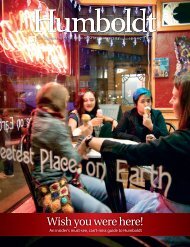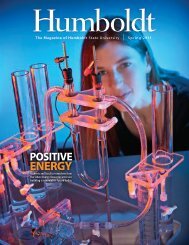Unveiled - Humboldt Magazine - Humboldt State University
Unveiled - Humboldt Magazine - Humboldt State University
Unveiled - Humboldt Magazine - Humboldt State University
You also want an ePaper? Increase the reach of your titles
YUMPU automatically turns print PDFs into web optimized ePapers that Google loves.
PHOTO THIS PAGE AND FACING PAGE COURTESY OF STEVE STEINBERG<br />
CALIFORNIA’S CENTRAL VALLEY is America’s<br />
salad bar, an agricultural cornucopia where more<br />
than half the nation’s fruits and vegetables are<br />
grown. But behind the glistening produce lies a<br />
story rife with contrasts. It’s one of opportunity<br />
and isolation, abundance and deprivation, healthgiving<br />
nutrition and malady-inducing toxins.<br />
The valley’s farmworkers are mostly Latino, and their<br />
homes are clustered in and around the fields in which they<br />
work. The tight-knit, low-income communities are served<br />
by nearby small markets, banks and schools for the laborers’<br />
children. That proximity to agricultural worksites<br />
places workers in the pesticide hot zone, day and night.<br />
Workers, their families and the industrial chemicals all<br />
share common space, but helping the layperson understand<br />
the connections between pesticides, populations and health<br />
hasn’t happened—until now.<br />
Facing page: Farmworkers harvest crops in Tulare County, Calif. A new study by HSU<br />
professors and students maps pesticide use and its proximity to sensitive facilities<br />
like schools and playgrounds in six California communities.<br />
HUMBOLDT STATE UNIVERSITY | humboldt.edu 15




